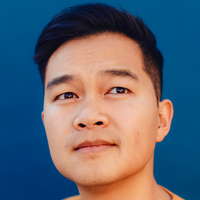On striking the right balance
Prelude
Gracelee Lawrence’s work deals with relationships between food, the body, and technology. It is born in the transfigurative space between physical and digital reality, exploring the ways in which bodies are both gendered and metaphorically fragmented in terms of capitalist-driven material desires, physical sustenance, and the digital spaces we inhabit. She opened her first solo show in New York at Thierry Goldberg in May 2019. She is a member of the collective MATERIAL GIRLS and is currently a Visiting Assistant Professor of Sculpture at the University at Albany, SUNY.
Conversation
On striking the right balance
Sculptor Gracelee Lawrence discusses discovering what it is you want to do, juggling day jobs, resisting the commodification of the art world, and how uncertainty informs her work.
As told to Sammy Maine, 2771 words.
Tags: Art, Education, Process, Politics, Collaboration, Multi-tasking, Inspiration, Mental health.
When did you realize you wanted to be an artist?
I had been making objects and thinking about materials and experiencing the joys and difficulties of the dimensional world for a really long time. But there was a moment in my sophomore year of college, when I was taking Sculpture-1, when I realized that actually sculpture was a thing that you could do. Once I realized that sculpture meant this amazing combination of formal material, qualities, and conceptual rigor, I was amazed, because it was exactly what I had always been looking for. I grew up going to museums in North Carolina, so I didn’t really understand what contemporary sculpture was. I knew it would take quite a bit of sacrifice, but maybe not as much at the time, as I know now.
What kind of sacrifices?
In that moment, I did know that it would shift the decisions I was able to make in my life. I knew that it would take a wild amount of time and energy and resources and mental space but I didn’t understand the extent to which I would feel so dedicated to it. I would put it pretty much above everything else. In the past couple of years, I’ve tried to temper that to some degree. My personal relationships are certainly the most important thing in my life, but sculpture took that role honestly for many, many years… for better or for worse.
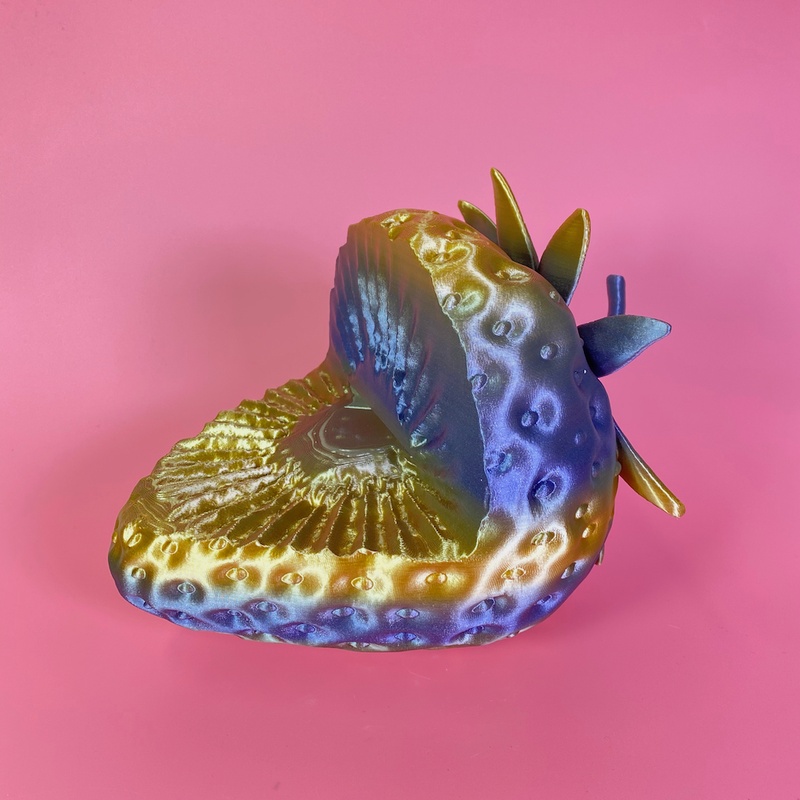
Trampled or in Your Hands, 2021, silk polylactic acid 3D print, 7 x 7 x 9.5 inches
When did you realize you had to shift those things around?
I spent two and a half years doing residencies where I was basically nomadic for that whole time. It has certainly informed the way that I think about my work and the way that I think about context and place. But during that time, I was always feeling like I was missing something; I was never quite certain about my path. Also the pragmatics of being an artist and that I had spent many, many years doing whatever it took in order to make the work. So working weird jobs, and working a lot of part-time jobs, and having an online job so that I could do these residencies. That was always just barely tacking ends together.
Things were kind of tenuous, which I feel like a lot of artists experience. But there came a point where I was like, okay, that’s not the way that I want to live anymore. I need a different kind of emotional and financial stability. It came when I met my current partner and the balance became really clear. And I was lucky that those things appeared to me at that moment.
Do you think that emotional stability and security has shifted the way you make your art?
I think so because I don’t have to move it every month. They’re huge. These objects are often bigger than me and maybe weigh the same amount as I do. They’re big things and they demand a lot of space and attention. So seeing them all together and being with them in the same room, and knowing that I can come back to [the studio] is so important. I’m able to consider the work in longer stretches and have a longer view because of that ability to be in one place and not be as tenuous.
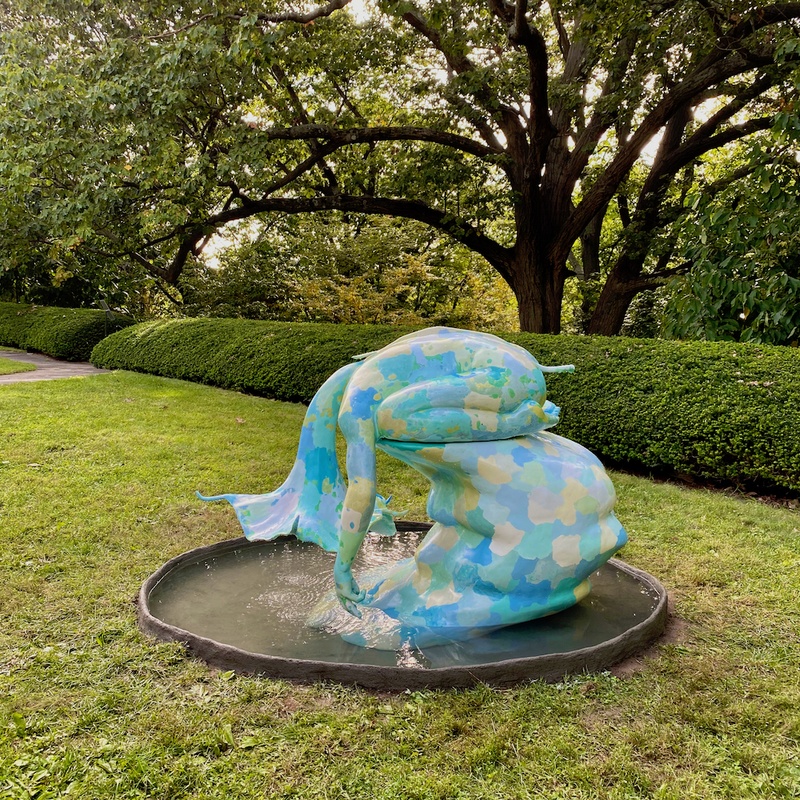
The Other Escapes, the Ones You Can Open in Yourself, 2020, 3d printed polylactic acid, foam, Fiberglas, epoxy putty, urethane tints, concrete, pump, tubing, 4.5 x 5.5 x 7.25 feet
Your work primarily focuses on food and the body. How did you reach that niche in your work?
I’ve always been thinking about my relationship with objects. Quite early on organic materials came into my work and I started thinking about what it means to deal with foods and fruit material. In my really early sculptures, I was collecting hair from my horse and crab claws and reformulating those into objects. I was thinking about these materials that have multiple meanings that exist in our life in multiple ways.
The crab claw is both: it can be eaten as this nutritive source, but then it also is operating on this object level, but it’s a little bit removed. It’s this thing that we both understand on a tactile level and a nutritive level, but then it is also an object that we can understand no matter what the scale is, no matter what the coloration is; there is a connection to those things. Then I started thinking about image versus material in the work and about accessibility; accessibility is something that I’m constantly considering, especially because I grew up in a really rural place. So I started thinking about ways that I could make my work and have it speak to many different audiences as a recognizable form.
I did this public art project at a sculpture park in Austin, Texas, and started thinking about image based reciprocation with the body and fruit… how fruit is used to understand the size of a tumor, or the size of a baby as it’s growing. If I scale up fruit and use it as this way to talk about bodies, and talk about these intrinsic things that we know about bodies and food, then that’s another point of access. I realized that the material was much less important than the image.
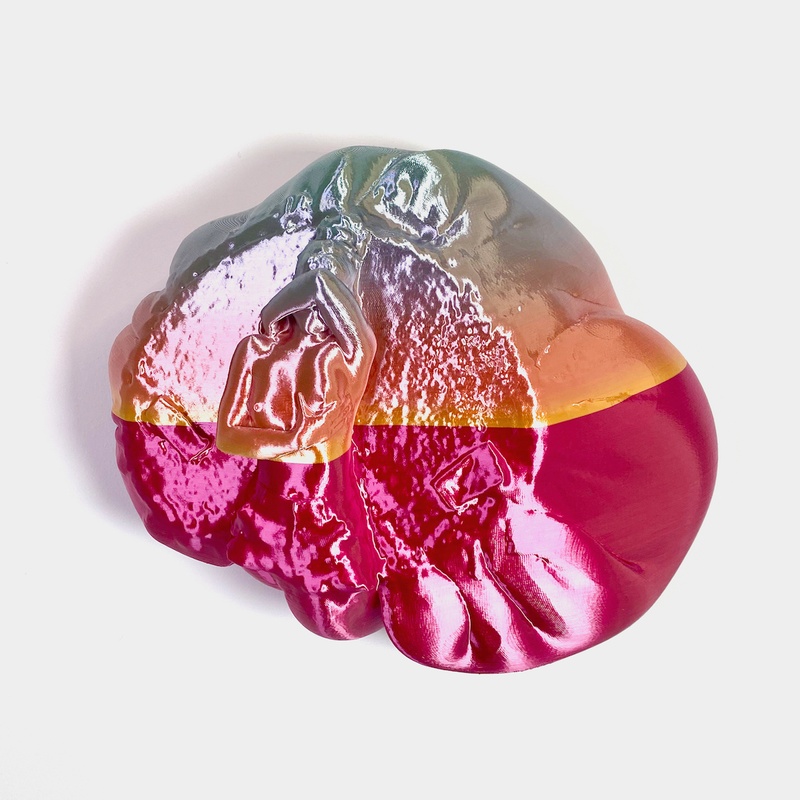
Sucked Empty by Too Many Eyes, 2021, Silk polylactic acid 3D print, 7 x 7 x 4 inches
And your work also focuses on capitalist-driven material desires. So, how do you navigate your artistic practice while living in the society that we do?
Art is a commodity. All of these [sculptures] are objects that theoretically, are meant to be purchased by people who can afford these big sculptures that then live in some storage room, and probably never see the light of day. If you look at the art market, that is really what it’s intended to do. That’s not what my work is intended to do; I don’t labor over these things so that they can be an investment for people. The way that I have always thought about my work is not in terms of the art market, but in terms of what it is supposed to address.
Part of the reason why I’m thinking about these capitalist systems and material desires is that food in particular is so political. Pineapples are one of my favorite examples; in the 1700s they were worth more than their weight in gold. It was this point of power. It was a point of taste. It was a point of exoticism. Well, who were all the bodies who were involved in making that thing arrive in England, or the Netherlands or wherever it may be? The line of human contact that it took to bring that object to that space is horrifying, but also extensive. So, tracing the history of certain foods is tracing the history of global capitalism.
Now you’re working as the Visiting Assistant Professor of Sculpture at Albany, SUNY and you were previously teaching at Kenyon College. Does teaching help or hinder your own practice?
Well, relatively speaking, it’s so much easier in my current life to balance my work, my financial gain work, and my real work here in the studio. But that’s because I’m so fortunate to have a job at a research university that supports my work, and is putting a focus on me spending time in the studio, and having the shows, et cetera: that has not always been the case. I spent many, many, many years doing absolutely whatever it took, minus having a full-time job, because I knew that having a full-time job, especially a 9:00 to 5:00 would just make it impossible for me to spend the time that I needed to with the work. That balance has always been something that has been difficult to find.
I do think that teaching for me is a really good addition to making and thinking about the work, and thinking about the structures of contemporary art making and why we bother to do this thing. I don’t necessarily know that academia is the best place to do that work and that teaching but it’s the place that I’m able to do it right now and for that I am grateful. But those systems are often really antithetical to the things that I’m trying to teach my students. But of all the things that I could be doing outside of spending time in the studio, making these things, it feels as though teaching is able to both support what’s happening here and allow me to continue to build structures of care and thought.
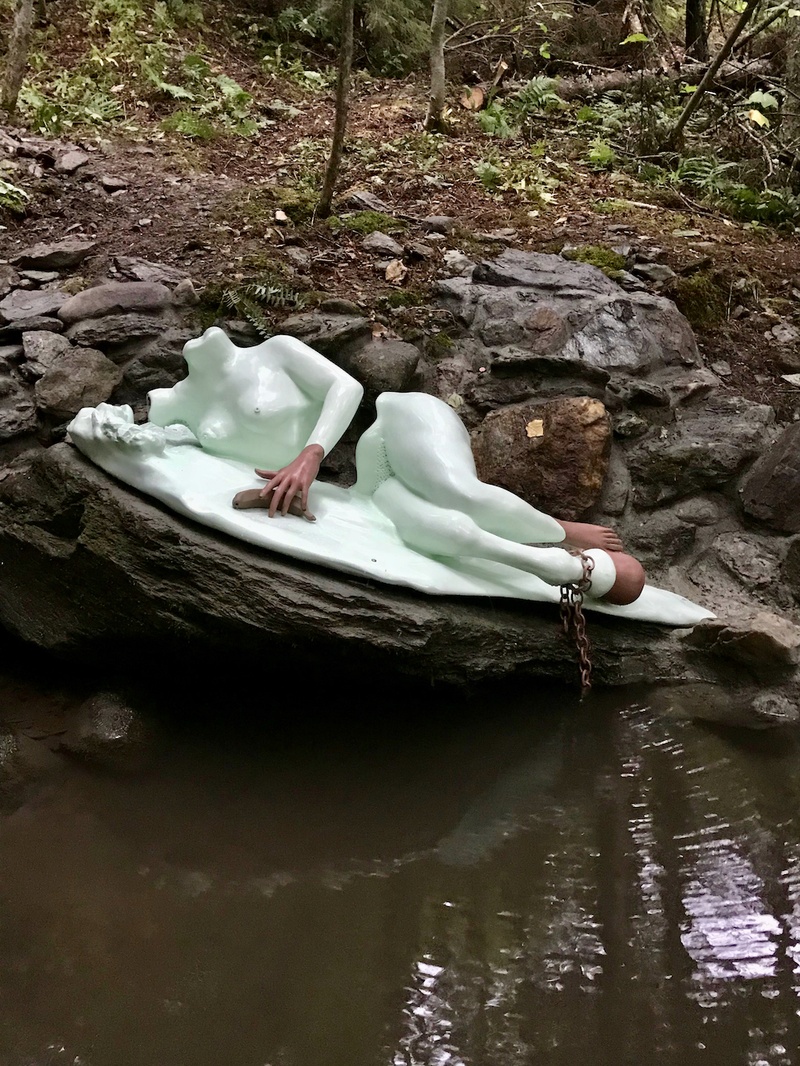
A World Without Genesis, 2018, 3D printed copper, 3D printed bronze, 3D printed plastic, CNC routed foam, fiberglass, epoxy, vinyl tubes, 36 x 78 x 42 inches
Looking around your studio, there are really small works on the coffee table, and then we have huge, bigger-than-us sculptures. What kind of things do you have to factor in before you even embark on a new piece?
Recently I’m going back to the constant dilemma and question of sustainability and stability in one’s practice. I’ve started doing these smaller print additions that are often smaller versions of the larger unique pieces. Those do end up having lives outside of the studio that end up going in people’s homes. That is another point of access and sustainability that’s super important in my art making: that my peers are able to buy these smaller sculptures and live with them and interact with them on a daily basis. The point is not to make a precious object that’s never seen, the point is to make something that’s asking people to continue questioning its form and its purpose.
In the fruit and body forms, I was thinking about bio-cyborgism and what it could mean to be in a future where we choose softer technology rather than rigid hard technology… where we choose what we combine with. What if we became softer like plant bodies? Each series has this core idea and then it will expand out from there. Often that’s happening in a series of really quick sketches, nothing precious, then the rendering will happen in computer space. Generally I’m using Rhino to do a lot of my rendering work and 3D scanning. Then I’ll have to decide on scale, which as you mentioned, can take all kinds of different directions from something that’s three inches to something that’s seven feet tall. Often I want these things to feel larger than body scale; I want them to feel like they are a little overwhelming as though they’re just on the edge of what’s knowable and holdable.
Do you ever abandon a piece of work?
Generally, if something comes into physical reality, I will see it through. It can take years, though, sometimes to determine what an object needs. There’s this object on the wall over here that I still don’t think is a good piece but it’s my reminder to have purposeful thinking and direction.
You’re part of the collective Material Girls that’s dedicated to “building community”—how does this community affect you and your work?
It’s been really important for me to have those folks in my life. We’ve been working together since 2017 and have always been remote to some degree, so there’s this continual feeling of connection, no matter where I am. Having a community of specifically female-identifying sculptors is hugely important in that the questions, issues, joys and difficulties that we experience are so specific. It’s such a tiny little world and so, having this group of women who are also dealing with the systems and structures of the art world has been just beyond wonderful. Also, we make work together. We think about different questions and systems and places in how we make our work together. There are paths that I certainly would not have followed had I not been thinking along with this group of people.
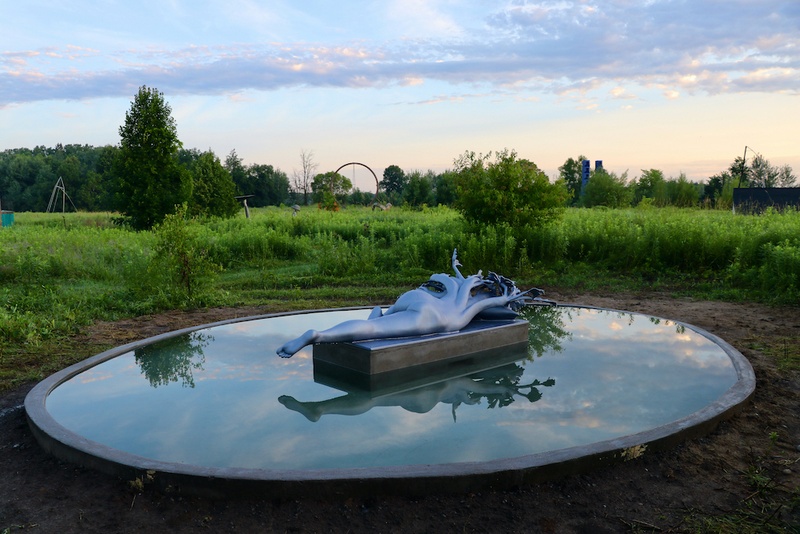
Perceived Happiness as the Ultimate Revenge, 2019, fiberglass, epoxy resin, foam, 3D printed plastic, epoxy putty, auto paint, tubes, fountain pumps, steel, concrete, 3 x 21 x 18 feet
A lot of your work comments on the natural world, and a lot of your pieces are on show in the natural world. But then you’ve also installed your work at the Albany Library and you showcase your sculptures inside galleries. How do you decide where people are going to interact with your work?
I have tried so many different types of spaces that at this point, I understand my boundaries a little bit more, and I understand what is necessary to make work for these different spaces. The way I approach making public work on an outdoor scale is so different than how I’m thinking about the indoor gallery work. So, they almost feel like different lines of consideration and process for me. But also situations that bring me outside of my expectations for what the objects do and how they can be contextualized, is really important to me.
So, doing things like the library windows in Albany, that was a really interesting exercise in thinking about flattened space and considering how those windows function both architecturally, and how people would interact with that space, versus someone who’s coming into a gallery with the intention of looking at sculpture. They’re very different places to begin. So often it starts with considering how someone will approach the work and why they happened to be in a space, and the perceived need of a person who is going to be experiencing it.
When did you first feel successful and has your definition of success changed since then?
It’s fleeting. I feel so wildly grateful to be in the position that I’m in: that I get to primarily focus on making objects. But there’s always more and jealousy is something that can easily cloud that lens. So it’s all relative to the mindset of the moment. I do feel as though I could have never planned for the life that I have now. When I was 19 and first understanding what sculpture was, I would have never in my wildest dreams thought that I could even be here and be doing this and have this as my life. And that I could be teaching at a university… that I could be someone who is dealing in sculpture in all aspects of my life. So that is a beautiful accomplishment to me.
Is there anything you would’ve done differently at 19 had you known that you would land here?
Definitely. I didn’t make any decisions in my undergrad education that would set me up to be in the position that I am now. I went to a small Quaker school in North Carolina, and it was the most amazing community: so supportive, so loving. It gave me this wildly strong support system and place of enthusiasm and care, but not the place that really set me up to understand what the contemporary art world was. In some ways I think that’s good but it put me on a bit of a different track. So it took me a long time to understand that place actually does shift what is possible. But at the same time, I grew up on a tobacco farm in rural North Carolina. My work speaks to that in important ways. I spent much of my 20s in rural North Carolina, riding horses for people and making sculptures in garages. So, it’s all relative to the moment. I think all of that certainly does inform how I deal with my work now. And also how I deal with people who were in a similar position than I was 10 years ago.
Gracelee Lawrence Recommends:
When Watched by Leopoldine Core
Banana: A Global History by Lorna Piatti-Farnell
The Cocteau Twins 1993 album Four-Calendar Café
Dorian Electra’s 2020 album My Agenda
casual birdwatching
- Name
- Gracelee Lawrence
- Vocation
- Artist, sculptor, teacher
Some Things
Pagination

